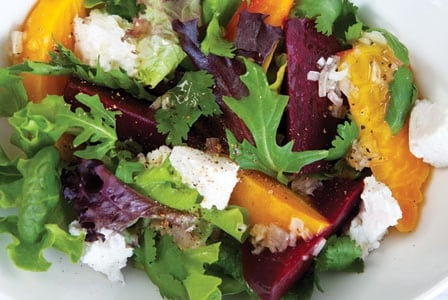
High in nutrients and low in kilojoules, the simple beetroot contains an abundance of health-protective antioxidants
High in nutrients and low in kilojoules, the simple beetroot contains an abundance of health-protective antioxidants. Eating a cup of beetroot is really like consuming a power-packed and tasty multivitamin—a simple and wholesome way to boost your health and well-being.
Red beetroots are tops
Most of us have eaten them now and again, in borscht or pickled. Today with the resurgence of fresh culinary inspiration brought by a growing culture of foodies, we can experience these delicious vegetables in a wide variety of innovative and delectable ways.
Beetroot can be found in a lovely array of vibrant colours ranging from white and yellow to deep crimson or candy-cane striped. While all of these can be used in a successful beetroot dish, some of the beetroot’s most beneficial phytonutrients—betalains, including betacyanin and betanin—are found specifically in the red pigments of this nutritious vegetable.
Yellow beetroots have another type of betalain called betaxanthin. Betalains exhibit antioxidant and anti-inflammatory properties and have been found to be of great assistance in general detoxification.
Raw, steamed, roasted, grilled, pureéd or juiced—don’t be afraid to experiment with your own recipes for this palatable root vegetable. The beetroot is truly one of Mother Nature’s treasures; for nutritional value, flavour and versatility, it simply can’t be beat!
Recipes
- Steamed Beetroot and Goat Cheese Salad
Did you know?
Like spinach and silverbeet, the beetroot is a member of the amaranth family (Amaranthaceae-Chenopodiaceae). Its ancestor is the wild beet, or sea beet, which dates all the way back to prehistoric times. Originally eaten for its leafy green tops, the roots were cultivated by the ancient Romans. By the 16th century they had become popular not only as livestock fodder, but also in family kitchens throughout northern Europe.
Preparing beetroot greens
Don’t compost all of those lovely beetroot tops—by weight they are richer in certain nutrients than the roots. High in beta carotene, vitamin C, calcium and iron, they’re a leafy vitamin shot in the arm. Use the larger leaves in any recipe that calls for spinach or silverbeet; the smaller, tender leaves make a great addition to any salad.
Here’s a quick and easy way to add the greens to your next meal:
- Cut washed beetroot tops into strips 1/2 to 3/4 in (1 to 2 cm) wide.
- Heat some extra-virgin olive oil in a pan; add some chopped spring onions or garlic. Add sliced beetroot tops; sauté uncovered until wilted, about 5 to 7 minutes.
- Remove from heat, add a dash of lemon juice and sea salt and sprinkle on sesame seeds or chopped nuts of your choice; toss.
Health benefits
The beetroot is rich in lutein, zeaxanthin, vitamin C and manganese, all of which have significant antioxidant value. While the particular antioxidants found in beetroot are especially beneficial for supporting eye and nerve tissue health, the anti-inflammatory properties of some of these components, including betalains and betaine, render the humble beetroot a potentially invaluable ally to those fighting cancer or heart disease.
To add even further to its health benefits, beetroot is high in
- soluble fibre, a known cholesterol buster
- folate, essential for normal tissue growth, protective against Alzheimer’s disease
- boron, involved in the production of sex hormones
- nitrate, which lowers blood pressure
- iron, which combats anaemia and fatigue
- silica and calcium, which help to prevent osteoporosis
Beetroot basics
Selecting and storing
Available year-round, the best time to buy beetroot is during growing season from April through August. Choose the smaller, thinner-skinned roots with good colour and tender, vibrant greens. To store, cut the greens off about 1 1/4 to 1 1/2 in (3 to 4 cm) above the base of the roots; store in separate, airtight bags in the fridge for a few days (greens) or weeks (roots).
Preparing
To prepare beetroot, wash under cold water; scrub roots lightly with a vegetable brush, if necessary. Since the phytonutrients in beetroots, particularly the betalains, are quite vulnerable to heat, the less cooking you expose them to, the better.
Steaming is the simplest and quickest way to get this gem of a vegetable to your table. Leave on some of the stem and taproot, then quarter and place in steamer for 15 minutes. Remove peel from cooled roots, if desired. If your hands become stained, rub with lemon juice to clean them.



